Touch light switch: why is it needed, types, marking, selection and connection
Technological progress does not stand still and eventually affects all spheres of human life. Home improvement was no exception. For example, the touch light switch, which appeared recently, has already managed to occupy a worthy niche in everyday life.
The device increases not only the level of comfort, but also increases the operational life of lighting devices, and also refers to stylish design elements.
Let's look at the principles of operation and design features of these devices together. What points you need to pay attention to when choosing and how to properly install the touch switch.
The content of the article:
Design features and principle of operation
The appearance of the classic model of an electronic switching device is almost identical to the touch panel and is a screen made of glossy electrochromic material (crystal glass) with markings applied to it. A wide variety of design options, colors and configurations of devices are presented.
Regardless of the external characteristics and the number of connected consumers, the design of the sensor device consists of the following main parts:
- Controller or control unit. Behind the decorative front screen is the active surface of the sensing element, which responds to various stimuli. Based on the type of touch switch, the stimuli are: touching the object of influence, in some models approaching, clapping, voice command.
- Semiconductor converter. In the previous block, a signal is generated, which in this section is converted into electric enough power to operate.
- Switching part. Through the switch, the main actions in the electrical circuit are carried out: opening, closing or smoothly regulating the degree of load supplied to the lamp.
Based on the device of the electronic product, its principle of operation is obvious: by making a light touch of the fingers on the panel, a signal is produced, which is converted and causes the relay to turn on.
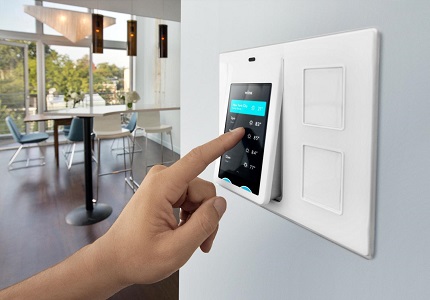
Distinctive features of the touch device
An electronic device belongs to the high-tech generation of devices, the main purpose of which is to control the illumination. The principle of its operation is based on adjusting the current with the help of a microcircuit; in ordinary switches, sliding contacts of a standard type are used.
Due to such a board, the formation of a short circuit is excluded. This means that the service life of the lamps is significantly increased, as well as the life of the circuit breaker itself.
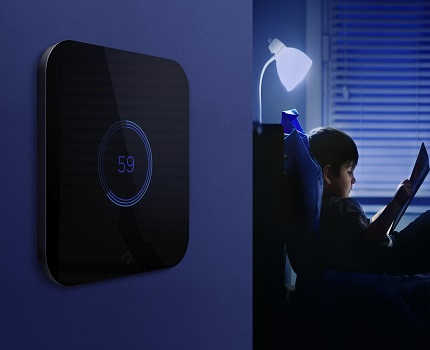
The maximum convenience of controlling lighting devices is the main advantage of the touch (electronic) switch.
It differs from the usual one by the presence of a special sensor, which served as the basis for the name of this species. The sensor located in the structure captures the radiated heat of the hands, responds to touch or to an audio signal.
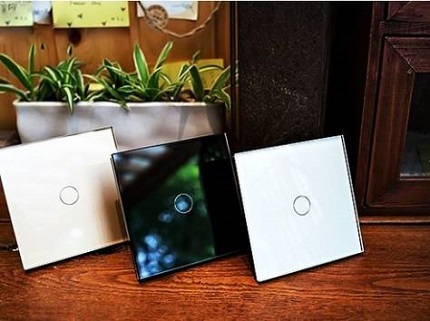
Since the self-sensing sensing element is not able to reproduce signals sufficient to start adjusting the lighting directly, the device uses amplification devices. Such conductors are transistors or other alternative elements.
For the distribution of amplifiers, the cascade placement method is used:
- The first place in the circuit, immediately after the sensor, is occupied by a transistor with high sensitivity and low power.
- The next in the oscillatory circuit is a similar mechanism, however with a lower susceptibility, but with enough power to transfer a large load to the element.
Quite often, electronic switches use galvanic isolation of the control circuit, where the control signal is sent by means of optical radiation - optocouplers. Thus, the fragile part of the mechanism, namely the sensors from the power, is separated.
It is also possible to use the radio range, where the sending of commands is carried out through the ether protocols of the involved wireless network, for example, BlueTooth or Wi-Fi.
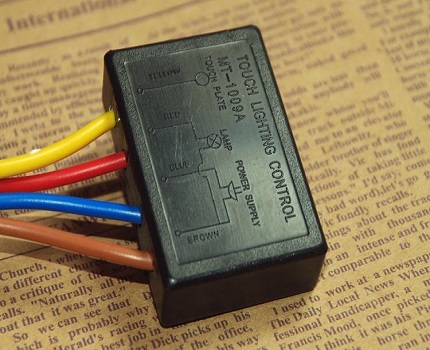
The power of the active elements that make up the electronic switch can be carried out using batteries or the mains. However, for the second option, it will be necessary to carry out certain manipulations to rectify the mains voltage and then cut it to the required level.
The simplest example is a Zener semiconductor diode. In rare cases, you can find a built-in full-fledged switching power supply.
Types of electronic switching products
Despite the fact that the touch switches are divided into six main types, only three are used in everyday life, namely: capacitive, optical and high-frequency. Let's consider them in more detail.
Are capacitive devices an excess or a necessity?
The capacitive type works as a light sensor and is able to record the location of an object at a set distance. The device is mounted instead of standard light switches, however, it does not require pressing a button / keyboard mechanism to operate it.
The essence of the work is based on the following algorithm of actions: when the hand approaches the sensitive area of the touch screen, mainly by 40-50 mm, the device performs a given command - it adjusts the lighting, turning it on or off. Some options require a light touch on the active switch panel.
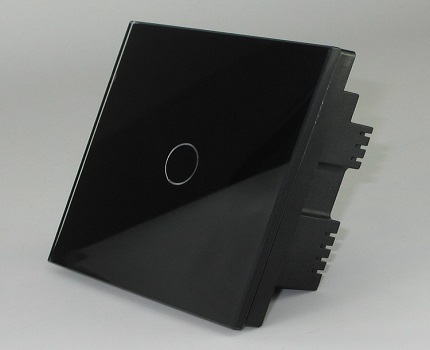
For some, such functionality will be perceived as an excess, but many consumers, especially their female half, appreciate the essence of such a mechanism.
For example, if during the cooking process in the kitchen you need to turn on additional lighting, then a slight movement of the hand, while it doesn’t matter if it is wet or dirty, can easily control the electronic switch.
The main representatives of capacitive electrical accessories for lighting control are produced by the companies: Jung, Berker, Livolo and Steinel. Despite the popularity, many developers abandoned such products and reoriented production to separately installed types of devices.
Comfort and economy of optical switches
A switch equipped with an infrared sensor senses exclusively thermal radiation in the infrared range emanating from the body during movement. Its alternative name is a motion or presence sensor.

The operation of this device is based on the operation of a sensitive pyroelement. The optical system redirects heat rays to a semiconductor receiver, surrounded by a storage lens made of plastic.
The last element is divided into segments. Due to this, the area in front of the infrared sensor is divided into sequentially located sensitive and insensitive zones, and accordingly, visible and blind sectors.
The principle of operation of the device is as follows: as soon as a moving thermal object enters the zone controlled by the lens, a voltage pulse is generated in the pyrodetector. By means of an amplifier, this signal increases, and the switch turns on the lamps.
When choosing intelligent regulator Lighting should pay attention to its technical part. One of the important elements is the mechanism that allows you to delay the time off the lighting. The duration of the off delay phase can be set to a few seconds or minutes.
The timer function is necessary to eliminate the problem of moving a person to the blind zone of the sensor when the pyroelectric receiver does not accept infrared radiation and issues a shutdown command.
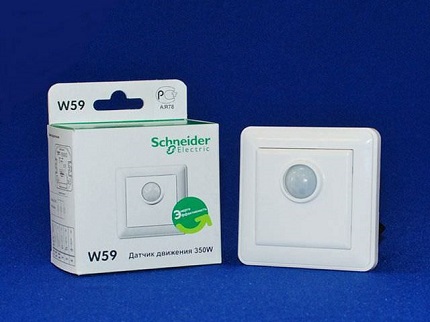
To block the operation of the infrared switch during natural daylight, almost all models are equipped with a regulating photosensor, which is installed in one of the positions - triggering at dusk or in complete darkness.
Manufacturers also ruled out the likelihood of sensor devices reacting to small objects, such as pets, the model range was expanded with infrared devices with an additional electronic controller for the heat radiation, which responds only to the movement of a subject weighing more than 20 kg.
No less interesting is the version with a complicated design, presented by B.E.G. motion sensors Such devices provide an acoustic control channel. When playing certain sound signals - clap, voice command, etc., lighting turns on.
Read more about how to choose and install a motion sensor. Further.
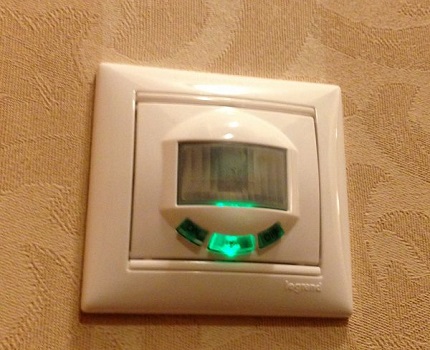
More recently, Siemens introduced the new Delta Reflex optical touch switch series. These are universal devices mounted in any area of the room, including external ones, with a degree of protection against external adverse factors IP 55.
High-tech models are equipped with a control panel, through which the programming of various functions is reproduced, for example, setting a timer to delay the time off or simulating the presence in a given period.
Convenience and practicality inhigh frequency appliances
High-frequency touch switches are represented by sensors of the active type (illumination) and volume. Structurally, these devices are quite similar to the previous version, but the principle of response is significantly different.
The detector is based on the use of photodiodes. At the moment of contact with the photosensitive region of light quanta, the device turns off the lighting equipment. At the same time, there is a special regulating mechanism in its body, with the help of which the required level of illumination is set.
Such intelligent mechanisms are more commonly used for lighting facades. When dusk sets in, they turn on the lights in the area, when it gets light, they turn it off.
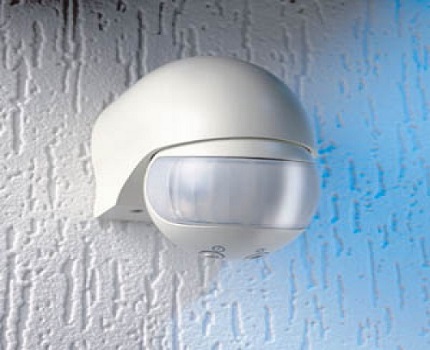
Popular models include sensors from German firms Steinel and Osram. Both products installed in place of the old light bulb and individual devices are presented.
Installation is carried out in the gap of the electrical circuit that supplies power to lighting equipment. The device has a high degree of protection, not less than IP 44.
The principle of operation of the volume sensor is based on the emission of weak high-frequency pulses reflected from various pieces of furniture and decor, floors and walls.
Having created a complete picture of the room in the field of reflected microwaves, the light control device inspects it with a certain frequency. If a new object appears in the zone, a command is formed and the light turns on, if nothing changes, then the device remains in off mode.
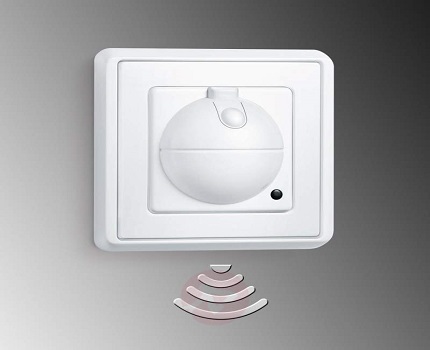
The main manufacturer of such devices is the same company Steinel. They are produced as switches installed instead of standard or, more expensive models, in the form of table lamps.
Marking and subtleties of connection
We will analyze the markings using the Livolo model VL C701R electronic switch as an example. Modification of the device is indicated by the Latin letters C6, C7, etc. Next, there is a two-digit number indicating the number of connected lamp groups: 01, 02 and 03.
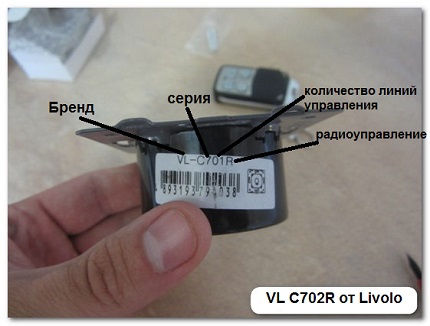
The last letters will indicate the additional functionality of the touch switch:
- R - radio control;
- D - dimmer mechanism, allowing smooth control of the degree of illumination;
- S - function of the passage switch;
- T - sleep timer.
The wiring diagram for the touch switch is the same as for standard single-key device or dimmer.
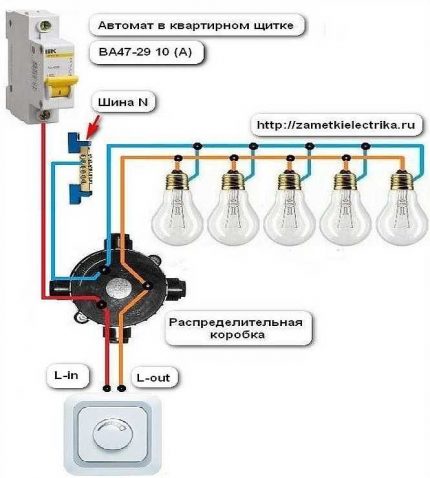
According to the above diagram, we connect the red line coming from the shield to the terminal L (In).
Next, the switching phase, in the orange figure, is connected to terminal L1 (Load). This wire is then routed to one or more groups of lamps.
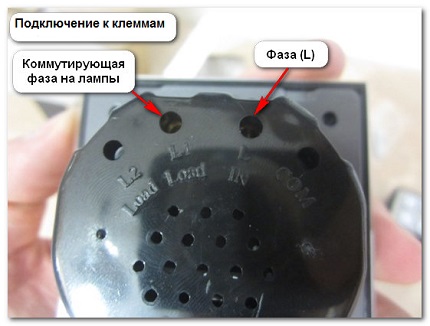
Zero conductors (N) are completed in one node by means of terminal blocks. Protective conductors (PE) are formed in a similar way.
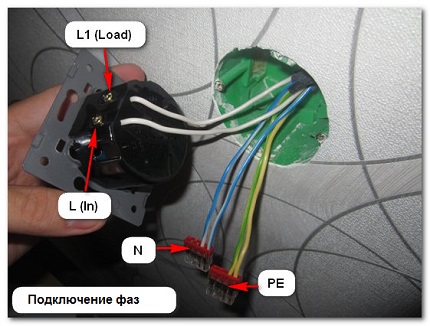
After neatly laying the conductors in the niche of the socket, they proceed to fastening the base of the switch and its overhead glass panel.
Choosing the best model
The main determining indicator for the full operation of the sensor switching device is the characteristic of the electrical network. The required voltage rating of 220 V is not suitable for all models. There are options with a deviation of 20-30%.
Therefore, when choosing, it is worth paying attention to the threshold voltage values indicated in the characteristics of the device. In case of significant deviations, it is necessary to additionally install a stabilizer, through which the oscillations will be leveled.
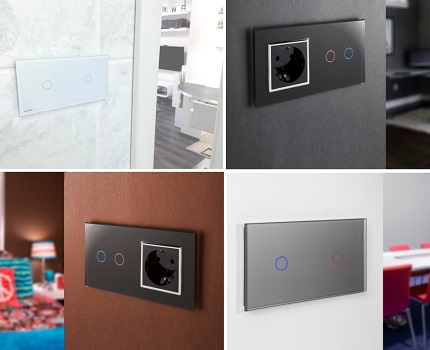
To determine the appropriate model of the sensor product, it is necessary to take into account the priority opportunities, the presence of which is necessary:
- Number of groups of bulbsconnected to the regulator - they can be one, two or three.
- Intensity. Some devices are additionally equipped with a dimmer, through which the amperage supplied to the bulbs changes.
- Built-in timer. In walk-through models, an automatic shutdown timer is set, which works after a specified time. These devices are mostly used for corridors and stairwells.
- Management method. It all depends solely on the preferences of the buyer. there is remote controlled devices, touch, sound, etc.
Having decided on the set of necessary functions, you should dwell on one of the manufacturers presented. The price category of devices does not apply to cheap ones; therefore, when purchasing a low-cost product, you may encounter a poor-quality analogue.
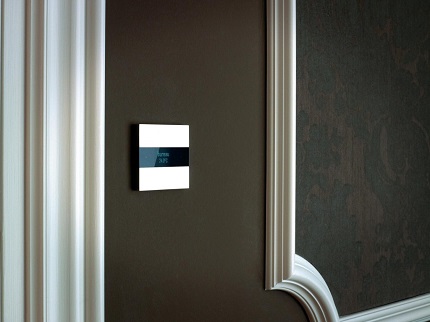
The Belgian company Basalte produce high-quality touch control devices. In development, they are oriented towards consumers with the highest demands.
Elite models differ not only in their original design, but also in one of the highest price categories. Nevertheless, the cost is fully compensated by the ease of use, the presence of various functions and simple regulation.
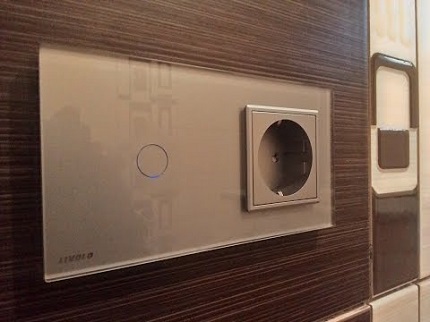
Among the Chinese representatives celebrate the company Livolo. The main advantages of the touch switches of this brand are the affordable cost of products and original design solutions for home improvement that can emphasize individuality.
However, the range is not limited to technically simple models. Also worth noting is the constant replenishment of the range.
We also recommend reading our other material, where we talked in detail about how we independently assemble touch switch.
Conclusions and useful video on the topic
If you decide to turn your home into an intellectual one, you should use the tips for choosing electronic models. About this in the plot:
Having decided on the model and the necessary functions, it is important to figure out how to reproduce the connection:
Despite the high price category, sensor switching devices are equipped with such powerful functionality, which is quite enough to equip a smart home system. By choosing and buying the right model that meets your needs, you can connect on your own.
Do you have personal experience using touch switches for light? Please share it with visitors to our site. Tell us about the advantages and disadvantages of such devices that you noticed. Write comments in the block under the article.

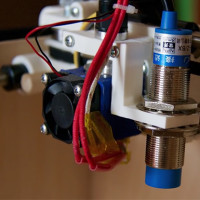 Why do I need a proximity switch + marking and features of its connection
Why do I need a proximity switch + marking and features of its connection 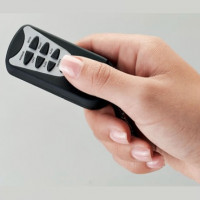 Light switch with remote control: types + overview of TOP brands
Light switch with remote control: types + overview of TOP brands 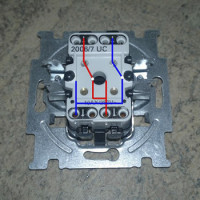 Rocker switch: marking, types, connection features
Rocker switch: marking, types, connection features 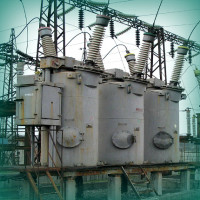 Oil switch: types, marking + specifics of use
Oil switch: types, marking + specifics of use 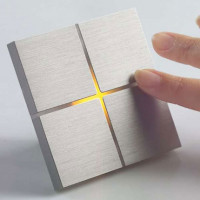 How to assemble a touch switch with your own hands: description of the device and assembly diagram
How to assemble a touch switch with your own hands: description of the device and assembly diagram 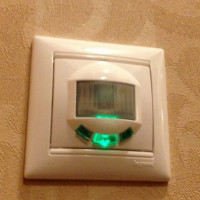 Switch with motion sensor: how to choose and install a light switch with a sensor
Switch with motion sensor: how to choose and install a light switch with a sensor  How much does it cost to connect gas to a private house: the price of organizing gas supply
How much does it cost to connect gas to a private house: the price of organizing gas supply  The best washing machines with dryer: model rating and customer tips
The best washing machines with dryer: model rating and customer tips  What is the color temperature of light and the nuances of choosing the temperature of the lamps to suit your needs
What is the color temperature of light and the nuances of choosing the temperature of the lamps to suit your needs  Replacement of a geyser in an apartment: replacement paperwork + basic norms and requirements
Replacement of a geyser in an apartment: replacement paperwork + basic norms and requirements
Everything is correctly written, progress does not stand still, it is not in vain that “smart homes” come into fashion. As for me, a touch switch is an essential thing. Firstly, because of the special board in such switches, short circuits are absolutely excluded, that is, the level of security is already higher. Secondly, if you buy a motion sensor along with such switches, you will get a good light saving. And the pocket does not hurt, and certainly the external environment)
In our house there is only one such switch, it is comfortable, and it looks modern. Although this thing just replaces the mechanical switch, but the sense of it is the same, it just looks different and looks more beautiful. Installed it myself. A switch with a motion sensor is a completely different matter, it’s a convenient thing in the hallway, electricity significantly saves, and there’s nothing complicated in the installation either.
Such touch switches look chic of course, I can’t say anything. But they need to be installed only if the design of the apartment itself is conceptually suited to this miracle of technology.